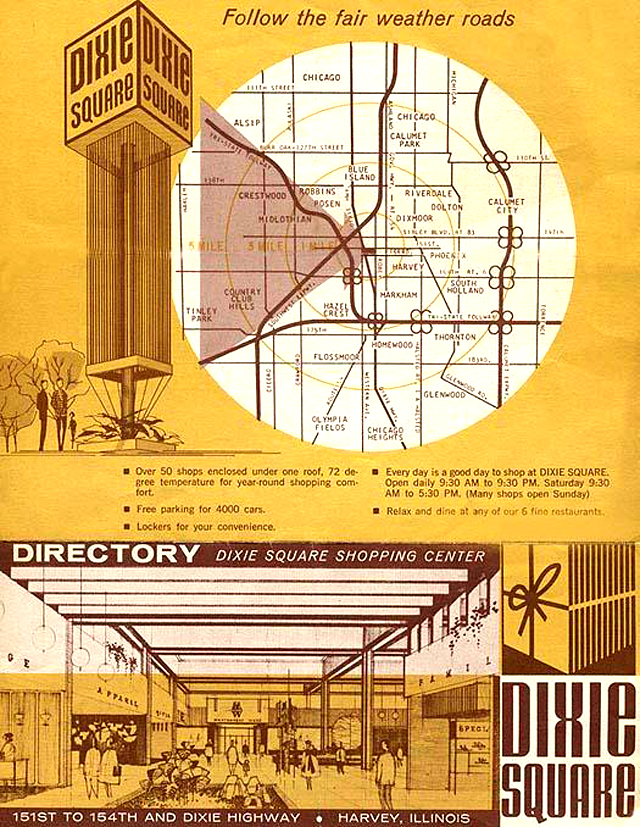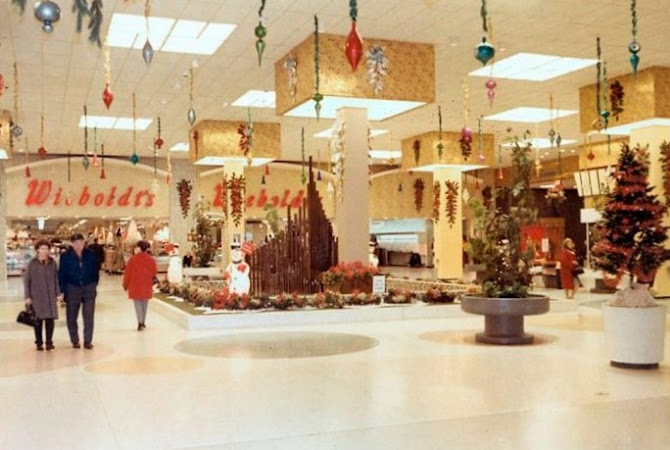Planning began for a Yorktown Center mall in 1965. The huge shopping complex was being developed by a joint venture of Carson Pirie Scott & Co., Montgomery Ward, JCPenney, and Wieboltds.
The mall site at Butterfield Road and Highland Avenue, Lombard, Illinois, comprised 190 acres, 22 miles west of "The Loop." Previously in an unincorporated section of Dupage County, it was annexed into the Village of Lombard in March 1966. Ground was broken in March 1967. Yorktown Center was designed by Los Angeles-based Victor Gruen Associates and Sidney H. Morris & Associates of New York City.
 |
| The $25 million Yorktown Center was dedicated in October 1968. The huge complex was the second-largest enclosed mall east of the Mississippi at that time. |
A 3-level (203,100 square foot), Chicago-based Wieboldt's became the first operational store on August 15, 1968. A 2-level (240,000 square foot) Montgomery Ward, the mall's largest tenant, welcomed its first patrons on September 26. Carson Pirie Scott's 3-level (219,000 square foot) store and a 2-level (230,800 square foot) JCPenney opened as part of the mall's dedication on October 10, 1968.
Soon after its completion, the Yorktown Center was supplemented by the freestanding Yorktown Convenience Center. Built adjacent to the north parking area, the store strip was completed in late 1969. Its largest tenant was a National Foods supermarket.
Attending the dedication ceremony were Samuel H. Shapiro (Governor of Illinois), Lester J. Bergmann (Mayor of Lombard), and developers E.D. Pehrson and T.D. Berenson. The festivities centered around unveiling a 25-foot-high thermometer in the mall's Grand Court.
Charter inline stores included Jarman Shoes, Florsheim Shoes, Chandler's Shoes, Frank's Shoes, Madigan's Apparel, Karoll's Apparel, Gangi men's wear, Seno & Sons men's wear, Bond Clothes, Walgreen Drug, Hickory Farms of Ohio, Armand's restaurant, Gilmore's ladies wear and a 2-level F.W. Woolworth 5 & Dime.
 |
| A 2-level Woolworths opened for business in September 1968 and would be a tenant for nearly 30 years. |
Outparcel structures included Ward's Auto Center and two fast-food restaurants.
The General Cinema Corporation Yorktown Cinema I & II opened on July 3, 1970. This freestanding venue was expanded into the Yorktown Cinema I-II-II-IV in August 1976 and into a 6-multiplex in the late 1980s. It was demolished in 1997 and replaced with the General Cinema Corporation Yorktown Cinema 18-multiplex, which showed its first features on April 3, 1998.
Meanwhile, a twenty-seven-store Convenience Center had been built adjacent to the mall's north parking area. Its original tenants included Radio Shack, Puppy Palace, Stevenson's Bath & Boutique Center, Goodman Yarns, Barrett Magnavox Home Entertainment Center, The Best Steak House, and Bar & Flame Furniture. Boushelle For Carpeting, Klein's Sporting Goods, Ace Hardware and a National Foods supermarket.
Major shopping hubs in the Yorktown trade area included Oakbrook Center (1962), 3 miles east, in Oak Brook, and Woodfield Mall (1971), 14 miles north, in Schaumburg. This complex completed an expansion in 1973, which demoted Yorktown to the second-largest mall in Chicagoland.
Anchor store rebrandings at Yorktown were set in motion on March 20, 1987, when the Wieboldt's store went dark. It would sit vacant for 7 years. Davenport, Iowa-based Von Maur renovated the building into a flagship location dedicated on July 18, 1994. Montgomery Ward closed in March 2001, with its vacant building being demolished in late 2004.
The first renovation of Yorktown Center was done in the mid-1980s. This project added new flooring, neon lighting and skylights, with shopping concourse stairways replaced with elevators. A second remodeling commenced in March 1993. The 12-bay Plaza Food Court was built in space vacated by a Madigan's apparel store in September 1992. The new food facility opened for business in November 1993. Original vendors included Auntie Anne's Pretzels, Chicago Hot Dog, Cinnabon, Sakkio Japan, Great Steak & Potato Company, Panda Express and Sbarro, the Italian Eatery.
 |
| The east anchor, which opened as a Windy City-based Wieboldt's, went dark in July 1987 and sat vacant for 7 years. Von Maur renovated the building and dedicated their store in July 1994. |
The renovation continued into the following year. New landscaping, lighting and seating were installed. Moreover, mall entrances were rebuilt. During a subsequent remodeling in the early 2000s, the Grand Court was refurbished, with new escalators installed.
 |
| The Grand Court at Yorktown Center was refurbished as part of a 2010s mall makeover featuring a children's play area. |
A fourth renewal of the mall began in early 2005. The 230,000 square foot Shops on Butterfield replaced the demolished Wards. This enclosed, open-air lifestyle addition was officially dedicated in June 2007 and included twenty-three tenants. Among these were Belly Couture, The Denim Loft, Burr Ridge Eyewear, Mirobelli Shoes, a (32,500 square foot) Lucky Strike Lanes bowling alley and (33,200 square foot) Forever 21. Claim Jumper, Capital Grille, Buca di Beppo and Rock Bottom Brewery restaurants were on the periphery of Shops on Butterfield.
In April 2012, Yorktown Center was acquired by a joint venture of New York City-based Kohlberg, Kravis, Roberts & Company (KKR) and El Segundo, California's Pacific Retail Capital Partners.
In April 2013, work commenced on an $18 million remodeling. The existing Plaza Food Court was upgraded during the project with expanded seating, wi-fi stations and a Family Lounge.
The culinary complex was renamed The Eatery. The Grand Court was refurbished with new seating, lighting and fountains.
The main mall entrance was rebuilt, and new signage was installed throughout the complex. The refurbishment was completed in June 2014.
Compiled by Dr. Neil Gale, Ph.D.

























































